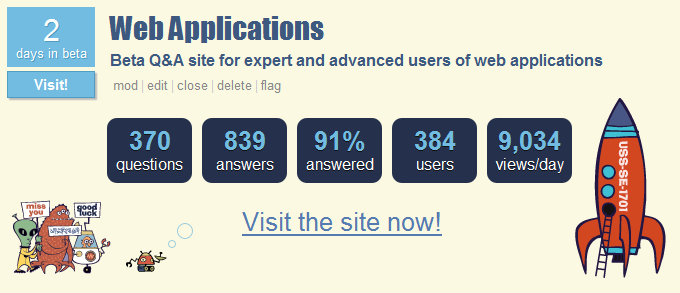What is the single most important design element of a new Q&A site? The name? The logo? The colors? The FAQ? Think about that for a moment — see if you know the answer — and we'll get back to the question later.
If you've spent any time on our back-channel at meta.stackoverflow.com, the most recent pastime has been proposing ways to redo Area 51. Most of the ideas suggest a need for more up-front discussion: discussion about the questions, discussion about tagging, discussion about the FAQ, etc. But in Area 51, most of that detailed discussion takes place in the last phase — in Beta.
Last week, Area 51 launched Web Apps, the first site to reach private beta. As with each new Stack Exchange site, Web Apps received its own meta discussion forum to discuss issues such as the site's design, what types of questions to ask, proper tagging, and picking a domain name. And among those earliest discussions, members were asking about the best way to seed the private beta site with questions.
Seeding the Site
I was a bit put off by the context implied by "seeding the site." The word seeding suggests to me that we're coming up with questions just for the sake of asking questions. My concern is, if people feel that the author doesn't really care about the answer, the whole exercise would likely be perceived as a waste of time.
But it's a popular way to avoid the classic "empty restaurant syndrome."

Back when Stack Exchange 1.0 sites were struggling, administrators had the problem of jump-starting their communities. The best way to overcome this classic chicken-or-the-egg problem was for the administrators to proactively seed the site with content. The downside is that those hypothetical questions tend to be somewhat pedestrian for an expert Q&A site. When put on the spot to post content, we're likely come up with uninspired questions that anyone would ask. And they've all been asked 100 times before on every other site on that subject.
But Stack Exchange doesn't have the empty restaurant problem. Case in point: One week prior to the full launch of Web Apps, we opened the site to a limited number of members for a short, closed beta test. Even with only a few hundred users, Web Apps quickly lit up with activity.
48 Hours of Web Apps:

How did Web Apps overcome the empty restaurant problem? Area 51 is designed to build up momentum for a site prior to launch. On opening day, hundreds (soon to be thousands) of people pile in to ask and answer questions when the site first opens. So when someone asks a question, it gets answered... quickly.
So when the meta discussion turned towards the seeding of questions, I suggested that we shouldn't be asking seed or sample questions on Web Apps. Users should be asking real questions about problems they actually have. That set off a bit of a panic. There was concern that a few hundred expert users will not likely have many real problems they need solving and, without that activity, the site would never get out of beta.
Well, to be fair, there's seeding and then there's "seeding."
It has long been established that no question is too entry-level nor too basic. Everyone is welcome. But, in these earliest days, we are DESIGNING a site for experts. To attract experts, you need a site where people are asking very interesting and challenging questions, not the basic questions found on every other Q&A site. Remember, the pro sites WILL attract the enthusiasts, but not the other way around!
The earliest questions on a site will set the tone and topic of the site for a long time.
And that's when it occurred to me: The earliest questions you ask on a Q&A site aren't about Q&A at all.
It's All About Design
Design doesn't just mean the obvious issues like designing the logo, or picking colors, or coming up with a name, or writing the FAQ. The very act of asking questions, answering questions, tagging, voting... everything. It's all about design.
That's why early participation is really, really important. Those earliest questions on your site say a lot about the community. So, if you want to ask question just for the sake of asking questions, at least make them really good ones. Ask real, expert questions.
In short, you are going to get the site you build.
Ask your first questions with an eye on the site's design. Those first questions will likely end up on the front page when potential experts see your site for the first time. Make those first questions exemplary questions that are worthy of imitation.
So, back to our quiz: "What is the single most important design element of a new Q&A site?" The answer is obviously, "The questions on the front page." Any other design issues after that are a distant second.